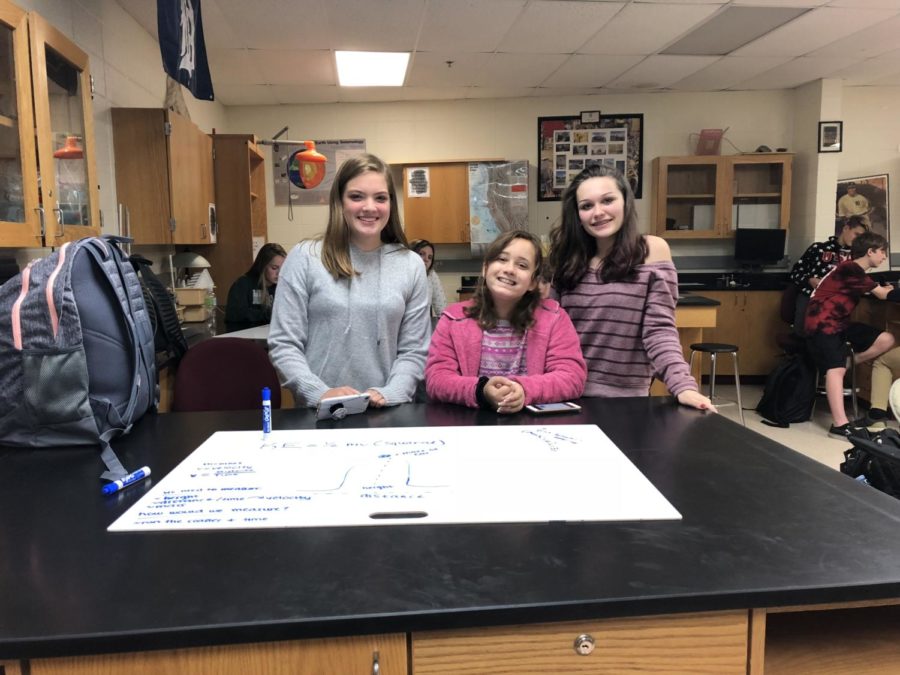The Physics First initiative has been implemented at Milford High
(Left to right) Grace Carey, Eriella Maki, and Grace Miller in physics class.
October 10, 2018
Since late 1990, the Physics First movement has become an integral part of select schools across the country. This campaign supports the “physics-chemistry-biology (PCB)” sequence of high school science classes.
According to an informational guide published in 2007 by the American Association of Physics Teachers, the 1800s setup that was in use in most schools as recently as last year did not take into account the advances that have been made in biological science. A statement by the association said that in order to understand molecular biology, students need a solid base in both physics and chemistry.
However, the movement has not been widespread. This is in part due to the fact that many states require biology class to graduate, whereas physics has lower requirement rates. Michigan in particular requires biology and either chemistry or physics, making the PCB sequence less practical. Milford High switched to the sequence due to new state requirements specifying a need for practice in scientific and engineering practice, disciplinary core ideas, and crosscutting concepts, which boils down to physics becoming a necessary class.
According to Nobel Prize-winning physicist Leon Lederman, a vocal supporter of the movement, around 2,000 US high schools have adopted the program for a portion of their freshmen, which is a small portion of the 37,100 high schools in the U.S.
Of the 2,000 schools that have implemented the program, many were private. This is an important distinction because private schools typically have the freedom and ability to adapt the program to individual students’ needs. They also have the means to get new physics teachers, a luxury public schools lack. This is due to the freedom in budget private schools have. In the public school system, the budgets’ distribution is determined by many different individuals and entities across several levels of government. Private schools have significantly fewer hoops to jump through, thus aiding in their acquisition of new physics teachers.
Many of the public schools who have implemented the program have therefore been forced to use “crossover teachers”. These are biology teachers who are now required to teach physics.
Here at Milford, veteran middle school teacher David Browne has been brought in to teach physics. As of recently, he has stated that both groups of students have an understanding of the concepts they have gone over, which is a good sign for the year.
“The new curriculum is really exciting. There’s lots of learning through experiments and not a ton of lecture. That’s exciting for us as teachers and hopefully exciting for our kids too. One of the coolest things about physics is you get to learn a lot about why things happen the way they do in the world around you. Our freshmen class this year have been rock stars so far and that has helped me a lot in teaching a new class too”’, said Browne.
These aforementioned groups–freshmen and juniors- are remaining separate in physics for the time being. This is due to the differences in their curriculum. The ninth grade class is tasked with completing a basic course. The juniors will cover all this material and build upon it, both in concepts and physical work. For instance, if the freshmen perform a lab, the juniors would participate in it as well, but then may be required to do a follow-up lab or other written piece. To sum it up, the juniors taking physics have a typical, challenging physics class whereas the freshman have a less extensive course.
The last question that many students care most about is how the program is working in real life, but that question cannot be answered in full at this point in time. The program has not been in use in any school system long enough to fully study its effects.
In addition to this, only 37 percent of students of public schools and 57 percent of students from private schools implementing Physics First use the full PCB sequence, according to AIP data. These factors combined make it incredibly difficult to determine how effective this initiative is.
The one documented effect of the PCB sequence is the increase of students who take physics. In 2005, 73 percent of students at public schools and 100 percent of students at private schools applying the Physics First sequence, whether complete or not, took physics at some point in high school.
These numbers are up significantly from the previous 31 percent and 57 percent, respectively, all according to AIP data. These numbers of course carry no significant meaning at this point due to the lack of academic progress information.
Nonetheless, Milford High has implemented this program with the hope of success. The students and teachers involved seem to carry on this sentiment.
Freshman Megan Temple states, “I like taking physics because biology seems more challenging.”
Another freshman, Angie Danowski says, “I personally like it (physics). We all have our own friend groups and we also get to develop new friendships. Biology might have more homework and more lectures which me and my peers personally don’t like”. These students attitudes–along with those of their fellow classmates– combined with Mr. Browne’s fresh perspective and open mind will hopefully lead to success here at Milford.
With any luck, Milford will have secured its place at the ground level of a major movement in scientific education.
